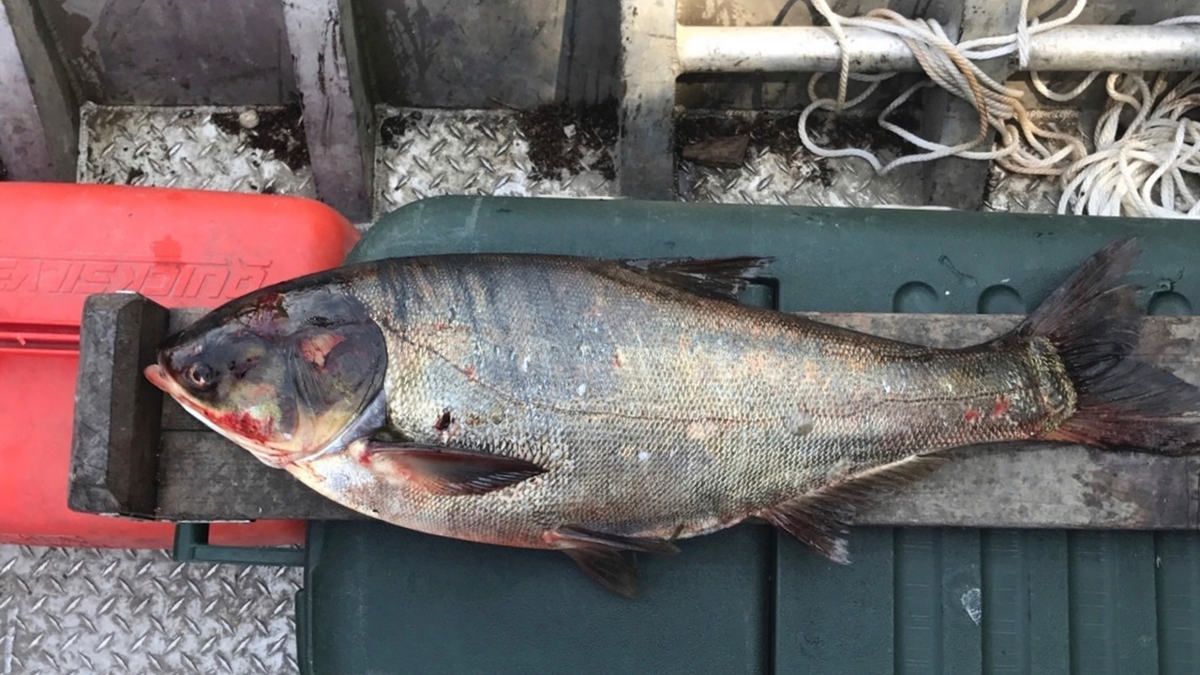
TRAVERSE CITY, Mich. – An adult Asian carp found in a Chicago waterway near Lake Michigan this summer began its life far downstream and apparently got around a series of electric barriers intended to keep the invasive species out of the Great Lakes, officials said Friday.
Autopsy results and a scientific analysis showed the silver carp, which was caught June 22, was a 4-year-old male that originated in the Illinois/Middle Mississippi watershed, according to the Asian Carp Regional Coordinating Committee, a coalition of government agencies.
It could have hatched anywhere along a roughly 200-mile (320-kilometer) stretch of the Illinois River before migrating northwest, said Charlie Wooley, the Midwest deputy regional director for the U.S. Fish and Wildlife Service. It spent time in the Des Plaines River before finding its way to the Little Calumet River just 9 miles (14 kilometers) from the lake, where a fisherman landed it.
The only way the carp could have gotten there was to evade three barriers in the Chicago Sanitary and Ship Canal some 37 miles (60 kilometers) from Lake Michigan, Wooley said. But it's unclear how that happened.
The barriers emit powerful electric pulses designed to repel carp that get too close or knock them out and possibly kill them if they don't turn back.
An earlier study raised the possibility that small fish could be pulled through the electric field in the wake of passing barges and survive.
Yet scientists who conducted a chemical analysis of the carp's inner ear bones to determine which waters it had been in concluded the fish had spent no more than a few weeks to a few months in the stretch of river where it was found. It was fully grown, measuring 28 inches (71 centimeters) long and weighing 8 pounds (3 kilograms).
"We're pretty darn confident a fish of this size would be incapacitated going through" the barriers, Wooley said, adding, "We're baffled and we just don't know how it got there."
Aside from the carp swimming through, another possibility is someone moved it past the barriers — intentionally or otherwise, said Kevin Irons, aquatic nuisance species program manager for the Illinois Department of Natural Resources. The fish might have jumped onto a boat and been carried past the barriers, then thrown out by an occupant who didn't realize what type it was, he said.
The analysis was conducted by experts with Southern Illinois University, the Fish and Wildlife Service and the U.S. Geological Survey.
The fish was only the second live Asian carp ever caught past the barriers; the other was in 2010. The find gave fresh ammunition to critics who question the effectiveness of the government's strategy for protecting the lakes. A search of the area where it was captured turned up no others.
"It confirms what we've known all along — those electric barriers are not foolproof and additional protections are needed," said Molly Flanagan of the Alliance for the Great Lakes, a Chicago-based environmental group.
Scientists warn that bighead and silver carp, both imported from Asia decades ago, could out-compete native species for food if they become established in the Great Lakes, where commercial and sport fishing are worth billions of dollars annually.
Environmental groups and officials in some of the region's states, including Michigan, have called for separating the Great Lakes and Mississippi River watersheds by installing dams or other physical barriers in the Chicago waterways.
Officials and industry leaders in Illinois and Indiana oppose that, saying it would disrupt freight shipping on the busy waterway.
The U.S. Army Corps of Engineers this month released a report calling for $275 million in technological and structural upgrades at the Brandon Road Lock and Dam near Joliet, Illinois, part of the aquatic chain that connects Lake Michigan to the Asian carp-infested Mississippi River watershed.
Sen. Debbie Stabenow, a Michigan Democrat, said the examination of the silver carp proved it had gone past Brandon Road during its upstream journey.
"Time is of the essence to both implement a permanent solution and take immediate steps to stop Asian carp from reaching our Great Lakes," Stabenow said.
Wooley said the discovery of the single carp past the barriers doesn't mean they are ineffective.
"It just shows we've got to be constantly on our toes, sampling the system and learning about the system to make sure the fish don't get ahead of us," he said.
___
Follow John Flesher on Twitter at http://www.twitter.com/JohnFlesher
___
Sign up for the AP's weekly newsletter showcasing our best reporting from the Midwest and Texas: http://apne.ws/2u1RMfv

